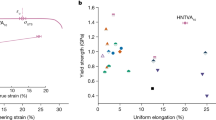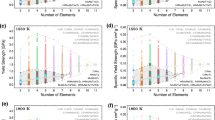Abstract
While rhenium has proven to be an ideal material in fast-cycling high-temperature applications such as rocket nozzles, its prohibitive cost limits its continued use and motivates a search for viable cost-effective substitutes. We show that a simple design principle that trades off average valence electron count and cost considerations proves helpful in identifying a promising pool of candidate substitute alloys: The Mo–Ru–Ta–W quaternary system. We demonstrate how this picture can be combined with a computational thermodynamic model of phase stability, based on high-throughput ab initio calculations, to further narrow down the search and deliver alloys that maintain rhenium’s desirable hcp crystal structure. This thermodynamic model is validated with comparisons to known binary phase diagram sections and corroborated by experimental synthesis and structural characterization demonstrating multiprinciple-element hcp solid-solution samples selected from a promising composition range.








Similar content being viewed by others
References
I.E. Campbell, D.M. Rosenbaum, and B.W. Gonser: The availability, recovery and properties of rhenium metal. J. Less-Common Met. 1, 185 (1959).
J-C. Carlen and B.D. Bryskin: Rhenium—A unique rare metal. Mater. Manuf. Processes 9, 1087 (1994).
P.J. Fink, J.L. Miller, and D.G. Konitzer: Rhenium reduction—Alloy design using an economically strategic element. JOM 62, 55 (2010).
A. Wrona, M. Stasewski, M. Czepelak, M. Woch, M. Kaminska, M. Osadnik, and D. Kolacz: Properties of rhenium-based master alloys prepared by powder metallurgy techniques. Arch. Mater. Sci. Eng. 45, 95 (2010).
A. van de Walle, R. Sun, Q-J. Hong, and S. Kadkhodaei: Software tools for high-throughput CALPHAD from first-principles data. Calphad 58, 70 (2017).
D.G. Pettifor and A.H. Cottrell: Electron Theory in Alloy Design (The Institute of Materials, London, 1992).
D. Pettifor: Bonding and Structure in Molecules and Solids (Oxford University Press, New York, 1995).
M.M. de Jong, J. Kacher, M.H.F. Sluiter, L. Qi, D.L. Olmsted, A. van de Walle, J.W. Morris, A.M. Minor, and M.D. Asta: Electronic origins of anomalous twinning in hexagonal close packed transition metals. Phys. Rev. Lett. 115, 065501 (2015).
C. Berne, A. Pasturel, M. Sluiter, and B. Vinet: Ab initio study of metastability in refractory metal based systems. Phys. Rev. Lett. 83, 1621 (1999).
M. Sluiter: Some observed bcc, fcc, and hcp superstructures. Phase Transitions 80, 299 (2007).
M. Sluiter: Lattice stability prediction of elemental tetrahedrally close-packed structures. Acta Mater. 55, 3707 (2007).
B. Seiser, T. Hammerschmidt, A.N. Kolmogorov, R. Drautz, and D.G. Pettifor: Theory of structural trends within 4d and 5d transition metal topologically close-packed phases. Phys. Rev. B 83, 224116 (2011).
T. Hammerschmidt, R. Drautz, and D.G. Pettifor: Atomistic modelling of materials with bond-order potentials. Int. J. Mater. Res. 100, 1479 (2009).
I. Karakaya and W.T. Thompson: Ag–Ru (Silver–Ruthenium), Binary Alloy Phase Diagrams, 2nd ed., T.B. Massalski, ed. (ASM International, Materials Park, Ohio, 1990); p. 84.
M.R. Baren: Ag–Mo (Silver–Molybdenum), Binary Alloy Phase Diagrams, 2nd ed., T.B. Massalski, ed. (ASM International, Materials Park, Ohio, 1990); p. 59.
R. Krishnan, S.P. Garg, and N. Krishnamurthy: Mo–Ta (Molybdenum–Tantalum), Binary Alloy Phase Diagrams, 2nd ed., T.B. Massalski, ed. (ASM International, Materials Park, Ohio, 1990); p. 2671.
C.P. Wang, J. Wang, S.H. Guo, X.J. Liu, I. Ohnuma, R. Kainuma, and K. Ishida: Experimental investigation and thermodynamic calculation of the phase equilibria in the Co–Mo–W system. Intermetallics 17, 642 (2009).
R. Krishnan, S.P. Garg, and N. Krishnamurthy: Ta–W (Tantalum–Tungsten), Binary Alloy Phase Diagrams, 2nd ed., T.B. Massalski, ed. (ASM International, Materials Park, Ohio, 1990); p. 3438.
C.S. Oh, H. Murakami, and H. Harada: Thermodynamic evaluation of the Mo–Ru system. J. Alloys Compd. 313, 115 (2000).
H. Okamoto: Mo–Ru (Molybdenum–Ruthenium), Binary Alloy Phase Diagrams, 2nd ed., T.B. Massalski, ed. (ASM International, Materials Park, Ohio, 1990); p. 2656.
O. Levy, M. Jahnatek, R.V. Chepulskii, G.L.W. Hart, and S. Curtarolo: Ordered structures in rhenium binary alloys from first-principles calculations. J. Am. Chem. Soc. 133, 158 (2011).
A.A. Mousa, J.M. Khalifeh, and B.A. Hamad: Electronic, elastic structure and phase stability of TaRu shape memory alloys. Am. J. Condens. Matter. Phys. 3, 1 (2013).
S. Kadkhodaei and A. van de Walle: Free energy calculations of the mechanically unstable phases of PtTi and NiTi. Acta Mater. 147, 296 (2018).
H. Okamoto: Ru–Ta (Ruthenium–Tantalum). J. Phase Equilib. 12, 395 (1991).
H. Okamoto: Ru–W (Ruthenium–Tungsten), Binary Alloy Phase Diagrams, 2nd ed., T.B. Massalski, ed. (ASM International, Materials Park, Ohio, 1990); p. 3269.
S.V. Kabanov, I.M. Subbotin, and T.P. Loboda: Physico-chemical investigation of molybdenum and ruthenium with tantalum and tungsten interaction. Fazovye Ravnovesiya Met. Splavakh, 266/9; C.A. 96 (1981) No. 206268.
I.M. Subbotin, M.V. Raevskaya, T.P. Loboda, and E.M. Sokolovskaya: The reaction of molybdenum and ruthenium with transition metals of period VI. Moscow Univ. Chem. Bull. 36, 51 (1981).
A. Zunger, S-H. Wei, L.G. Ferreira, and J.E. Bernard: Special quasirandom structures. Phys. Rev. Lett. 65, 353 (1990).
A. van de Walle, P. Tiwary, M.M. de Jong, D.L. Olmsted, M.D. Asta, A. Dick, D. Shin, Y. Wang, L-Q. Chen, and Z-K. Liu: Efficient stochastic generation of special quasirandom structures. Calphad 42, 13–18 (2013).
J-O. Andersson, A.F. Guillermet, M. Hillert, B. Jansson, and B. Sundman: A compound-energy model of ordering in a phase with sites of different coordination numbers. Acta Metall. 34, 437 (1986).
M. Hillert: The compound energy formalism. J. Alloys Compd. 320, 161 (2001).
U.R. Kattner: Thermodynamic modeling of multicomponent phase equilibria. JOM 49, 14 (1997).
A.T. Dinsdale: SGTE Data for pure elements. Calphad 15, 317 (1991).
A. van de Walle: Reconciling SGTE and ab initio enthalpies of the elements. Calphad 60, 1 (2018).
G. Kresse and J. Furthmüller: Efficient iterative schemes for ab initio total-energy calculations using a plane-wave basis set. Phys. Rev. B 54, 11169 (1996).
G. Kresse and D. Joubert: From ultrasoft pseudopotentials to the projector augmented-wave method. Phys. Rev. B 59, 1758 (1999).
P.E. Blöchl: Projector augmented-wave method. Phys. Rev. B 50, 17953 (1994).
J.P. Perdew, K. Burke, and M. Ernzerhof: Generalized gradient approximation made simple. Phys. Rev. Lett. 77, 3865 (1996).
A. van de Walle and G. Ceder: Automating first-principles phase diagram calculations. J. Phase Equilib. 23, 348–359 (2002).
M. Methfessel and A.T. Paxton: High-precision sampling for Brillouin-zone integration in metals. Phys. Rev. B 40, 3616 (1989).
P.E. Blöchl, O. Jepsen, and O.K. Andersen: Improved tetrahedron method for Brillouin-zone integrations. Phys. Rev. B 49, 16223 (1994).
A. van de Walle, Q-J. Hong, S. Kadkhodaei, and R. Sun: The free energy of mechanically unstable phases. Nat. Commun. 6, 7559 (2015).
A. van de Walle, S. Kadkhodaei, R. Sun, and Q-J. Hong: Epicycle method for elasticity limit calculations. Phys. Rev. B 95, 144113 (2017).
A. van de Walle: Multicomponent multisublattice alloys, nonconfigurational entropy and other additions to the Alloy Theoretic Automated Toolkit. Calphad 33, 266–278 (2009).
A. van de Walle, M.D. Asta, and G. Ceder: The alloy theoretic automated toolkit: A user guide. Calphad 26, 539–553 (2002).
A. van de Walle and G. Ceder: The effect of lattice vibrations on substitutional alloy thermodynamics. Rev. Mod. Phys. 74, 11–45 (2002).
W. Cao, S-L. Chen, F. Zhang, K. Wu, Y. Yang, Y.A. Chang, R. Schmid-Fetzer, and W.A. Oates: PANDAT software with PanEngine, PanOptimizer and PanPrecipitation for multi-component phase diagram calculation and materials property simulation. Calphad 33, 328 (2009).
A. van de Walle, C. Nataraj, and Z-K. Liu: The thermodynamic database database. Calphad 61, 173 (2018).
B. Sundman, U.R. Kattner, M. Palumbo, and S.G. Fries: OpenCalphad—A free thermodynamic software. Integr. Mater. Manuf. Innovation 4, 1 (2015).
B. Sundman, U.R. Kattner, C. Sigli, M. Stratmann, R.L. Tellier, M. Palumbo, and S.G. Fries: The OpenCalphad thermodynamic software interface. Comput. Mater. Sci. 125, 188 (2016).
Acknowledgments
The authors acknowledge support from the Office of Naval Research through program no. N00014-16-1-3124. Work at the Molecular Foundry was supported by the Office of Science, Office of Basic Energy Sciences, of the U.S. Department of Energy under Contract No. DE-AC02-05CH11231. AvdW acknowledges support from Brown University through the use of the facilities at its Center for Computation and Visualization. This work uses the Extreme Science and Engineering Discovery Environment (XSEDE) resource Stampede 2 at the Texas Advanced Computing Center through allocation TG-DMR050013N, which is supported by National Science Foundation Grant Number ACI-1548562.
Author information
Authors and Affiliations
Corresponding author
Additional information
This author was an editor of this journal during the review and decision stage. For the JMR policy on review and publication of manuscripts authored by editors, please refer to http://www.mrs.org/editor-manuscripts/.
Rights and permissions
About this article
Cite this article
van de Walle, A., Sabisch, J.E.C., Minor, A.M. et al. Identifying rhenium substitute candidate multiprincipal-element alloys from electronic structure and thermodynamic criteria. Journal of Materials Research 34, 3296–3304 (2019). https://doi.org/10.1557/jmr.2019.179
Received:
Accepted:
Published:
Issue Date:
DOI: https://doi.org/10.1557/jmr.2019.179




